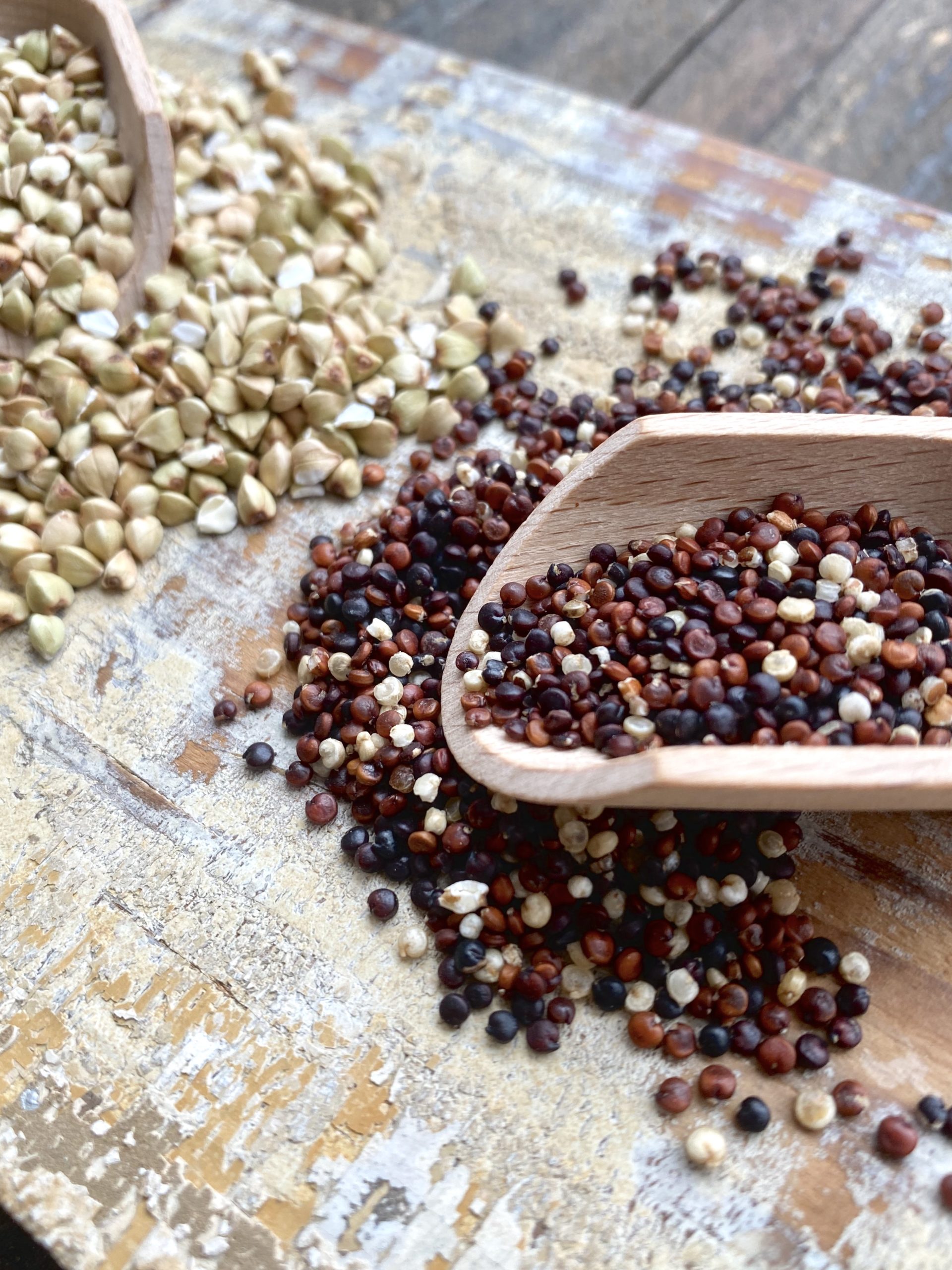Just because you’re cutting back on wheat, barley and rye during the low FODMAP elimination diet, doesn’t mean you can’t eat grains. Brown rice, oats, starch-rich corn meal as in polenta, tortilla chips and grits are low FODMAP. Some grain-like seeds such as buckwheat and quinoa are not technically grains–but offer a similar nutritional profile to grains.
Let’s review a few of the maybe ‘new to you’ grain-like seeds that are low FODMAP and nutritious such as: buckwheat, millet, teff, and quinoa.
Buckwheat is a nutrient dense fruit seed that is a relative to the rhubarb plant. Just 1/4 cup of buckwheat groats provides about 6 grams of protein and 5 grams of fiber! Buckwheat is a source of iron, calcium, potassium and zinc too. Despite the name, buckwheat is actually wheat and gluten free, and low FODMAP too.
Tips for using buckwheat in your diet: Add buckwheat groats to your favorite granola or overnight oats recipe. Buckwheat flour is traditionally used in many crepe recipes. You might incorporate buckwheat in your diet with my Glazed Blueberry and Buckwheat Scones. You can also find buckwheat cereal at some grocers to make a hot porridge.
Millet is sold as a whole grain seed. It’s an ancient “grain”, farmed over 10,000 years ago! If you think it looks like bird food, you are correct. Millet is often a component of bird feed blends. Millet is a gluten free and low FODMAP seed that is rich in magnesium and B vitamins. A 1 cup cooked portion contains about 6 grams of protein and 2 grams of fiber.
Tips for using millet in your diet: use as an alternative to rice in recipes. I like to add millet to my homemade granola or granola bar recipes or as part of a seed topper for lactose free yogurt or a smoothie bowl. You can add this cooked grain to stir fries or use at the base of a low FODMAP nourish bowl. And as above, I love millet in my Glazed Blueberry and Buckwheat Scone recipe found here.
For a great granola recipe featuring millet, check out FODMAP Life’s recipe low FODMAP Millet, Coconut, Chia Cranberry Granola found here.
Quinoa is technically a whole grain seed but often is classified as a whole grain due to it similar nutritional profile. Quinoa is rich in protein offering 8 grams of protein per 1 cup, cooked, including all 9 essential amino acids. For an extra bonus, there are 5 grams of fiber in a 1 cup cooked serving of quinoa too!
Tips for using more quinoa in your diet: Try my delicious Kale Quinoa Salad with Lemon Dressing for starters! Another popular recipe here on the blog is the Chicken Quinoa Meatballs with Soy Sesame Drizzle! Quinoa is a star ingredient in one of my favorite gluten free, low FODMAP crackers, Mary’s gone Crackers –ORIGINAL crackers. Note: not all varieties of Mary’s Gone Crackers are made with low FODMAP ingredients. Be sure to check ingredients!
Teff is best known for its use in the Ethiopian flatbread injera. It is a protein rich seed that has a nutty and mild flavor. Teff is the smallest grain-like seed in the world. It provides about 7 grams of protein in 1/4 cup serving and is a source of Vitamin C, B vitamins, iron, magnesium and calcium as well. It is low FODMAP and gluten free.
Tips for adding teff to your diet: This quick cooking grain can be added to pancakes or enjoyed as a cereal. Teff flour can be used to make cookies (yum!), check out these healthy-ish low FODMAP Oatmeal Teff Dark Chocolate Chip Cookie recipe here.
I have been working on a seed based bar recipe to share with you on my Instagram feed–I am using buckwheat groats, flax seeds, millet, sunflower seeds, pumpkin seeds and even seed butter! So… if you want to “get your seeds on” -or in your tummy- be on the lookout on my Instagram feed here.

Emily
Hi Kate,
When you buy buckwheat do you buy it out of a bin at Whole Foods or is it prepackaged. Also, i see in the Monash App they list groats and kernels. I just want to be sure I get the right thing!
Michael Rosen
Kate,
At the beginning of your post, you listed a number of safe corn items. However, one corn item I’ve had trouble finding out about is hominy, either fresh-cooked or canned. Given that hominy is used to make grits and masa, I’m inclined to believe it’s reasonably safe. However, I don’t know if there are different types of hominy used for different purposes. Do you know whether or not hominy is an acceptable corn product?
Thanks for your help. And … Happy New Year!
Alanna Taylor-Tobin
Thank you for sharing my teff cookie recipe here. Love these tips – I learned so much!
Cristina
Hi Kate,
This is a very educational post! I too have IBS and to be honest, before I was diagnosed, my understanding of buckwheat and quinoa was 0 – mainly words on a supermarket tag. They have since become my best friends and I use them in my diet regularly. I wish this post had been around when I was trying to work out what I can/cannot eat after being first diagnosed, I may have gotten away from all that rice! You have a great website, filled with very useful information for people living with this condition. Thanks for sharing.
Cristina